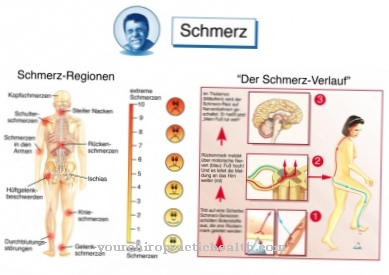The clinical picture of primary hyperaldosteronism is also known as Conn syndrome designated. It is characterized by high levels of the hormone aldosterone, which increases blood pressure.
What is primary aldosteronism?

© Double Brain - stock.adobe.com
This is the basis primary hyperaldosteronism in most cases either adrenal hyperplasia or adrenal adenoma. The result is an increased production of the hormone aldosterone. This raises the blood pressure so that the primary hyperaldosteronism often manifests itself through hypertension, i.e. high blood pressure.
This type of high blood pressure is called secondary because it is caused by a hormonal imbalance. It was previously believed that primary hyperaldosteronism is fundamental in only less than one percent of hypertensive patients. Nowadays, however, the prevailing assumption is that the clinical picture is even one of the most common reasons for hypertension.
Nevertheless, it is usually recognized late, namely when high blood pressure cannot be successfully adjusted even after therapy with three or more drugs. A lowered potassium level in the blood can also be measured. Although the symptoms do not differ from those of classic high blood pressure, the likelihood of secondary diseases such as stroke and heart attack is significantly higher.
causes
The cause of primary aldosteronism is a change in the adrenal cortex. This change affects a very specific zone, namely the Zona glomerulosa. In the Zona glomerulosa The adrenal cortex produces the steroid hormone aldosterone, which reduces the excretion of sodium and thus raises blood pressure because water is retained along with the sodium. At the same time, it increases the excretion of potassium.
If the adrenal cortex and the superordinate glands function normally, the blood pressure is regulated and adapted to current needs. In primary hyperaldosteronism, this control circuit no longer works, the adrenal cortex produces too much aldosterone. This is why high blood pressure occurs. The changes mentioned can be basically three pathologies, either bilateral adrenal hyperplasia, an aldosterone-producing adrenal adenoma or a familial change in the adrenal cortex.
As things stand, 70 percent of primary aldosteronism is due to bilateral adrenal hyperplasia and less than 30 percent to adenoma. The clinical picture is genetic in only less than 1 percent of the cases.
Symptoms, ailments & signs
Primary hyperaldosteronism is often symptomatic of arterial hypertension. Hypokalaemia and metabolic alkalosis can also be signs of the disease. However, all of these three classic symptoms rarely manifest themselves at once. Often the serum potassium is also in the low normal range.
The shift in the potassium level leads to fatigue, adynamia, constipation (constipation) and a mild form of diabetes insipidus, which is characterized by an increased urge to urinate and thirst. The reason for this is that the hypokalemia also affects the control circuits of other hormones and these get mixed up. The metabolic alkalosis, i.e. a shift in the blood pH value into the basic range, is also caused by the lowered potassium level.
Because of the potassium deficiency, more potassium ions are shifted from the cell interior to the cell exterior. This takes place in exchange with hydrogen ions. The kidneys also release hydrogen ions so that they can reabsorb more potassium. Overall, there is therefore a reduction in the hydrogen ions in the outer space of the cells. As a result, the metabolism becomes alkaline.
Diagnosis & course of disease
The diagnosis is made on the basis of the clinical symptoms and characteristic blood values. Secondary hypertension, such as primary hyperkalaemia, is likely to occur in high blood pressure, especially if the patient is very young, i.e. has not yet passed the age of 30, or if the hypertension occurs very suddenly in patients over 55 years of age.
Even if a significant increase in blood pressure suddenly occurs with proven regular medication, a secondary cause of hypertension must be expected. Furthermore, patients with primary hyperaldosteronism often lack the physiological nocturnal drop in blood pressure, because the hormonal control loop is disturbed by the overproduction of aldosterone. A possible secondary cause of high blood pressure should always be checked if there is no significant improvement even after the use of three antihypertensive drugs.
Blood is drawn to confirm the diagnosis. The high aldosterone value, a decreased renin concentration and activity and an increased aldosterone-renin quotient are noticeable. Hypokalaemia and metabolic alkalosis may also be present. Sodium is typically in the high normal range because hormonal counterregulation prevents hypernatremia.
Complications
The three characteristics hypertension, hypokalaemia and metabolic alkalosis are responsible for the high risk of complications in primary aldosteronism. Chronic hypertension (high blood pressure) damages the cardiovascular system in the long term and can lead to arteriosclerosis, angina pectoris and myocardial infarction in the long term. The hypokalemia leads to muscle weakness, paralysis of the smooth muscles, cardiac arrhythmias up to ventricular fibrillation and sometimes even to the rapid breakdown of the striated muscles (rhabdomyolysis).
Smooth muscle paralysis can block vital functions of the body. The intestinal or bladder muscles may be paralyzed, which can lead to bladder paralysis with urine congestion or a paralytic intestinal obstruction. By breaking down the muscles, rhabdomyolysis leads to severe muscle weakness, muscle pain, nausea, vomiting and fever. In very severe cases, the ischemia can lead to extensive muscle breakdown.
This is an emergency that requires medical attention more quickly. In metabolic alkalosis, the blood pH rises above 7.43. This is also a medical emergency that manifests itself through convulsions up to tetany, paresthesias, impaired consciousness and confusion. If the normal PH value is not restored quickly, death can also occur here.
Furthermore, primary hyperaldosteronism is characterized by symptoms such as polydipsia (insatiable thirst) and polyuria (excretion of large amounts of urine). The polyuria can lead to desiccosis (dehydration) of the organism despite large amounts of drink.
When should you go to the doctor?
Disorders and peculiarities of the cardiovascular system must always be clarified by a doctor. The cause can be serious illnesses for which action is required. High blood pressure, palpitations, internal heat, or persistent restlessness should be presented to a doctor. Interruptions to sleep, discoloration of the skin and hectic behavioral traits indicate a health impairment. A doctor's visit is necessary as soon as the symptoms persist or increase.
Disorders of the digestive tract are also considered unusual. If there is constipation or a feeling of pressure in the intestines, a doctor's visit is necessary. If the person concerned refuses to eat because of the symptoms, a doctor must be consulted. A doctor should be presented with a feeling of pressure in the abdomen, pain, or general malaise. Changes in weight, malaise, apathy, or a loss of wellbeing should be investigated further by a doctor.
A sudden increase in thirst should be understood as a warning signal from the organism. If the affected person consumes significantly more fluids than usual for no apparent reason, the observation should be discussed with a doctor. An increased need to urinate is just as unusual. This must also be examined.
Disorders of the metabolism or irregularities in the hormonal balance indicate a disease. If there are mood swings, changes in libido or behavioral problems, a doctor is needed.
Therapy & Treatment
Confirmatory tests are carried out if the suspicion of primary hyperaldosteronism is confirmed. These are, on the one hand, the salt stress test and, on the other hand, the fludrocortisone inhibition test. In the salt stress test, the aldosterone secretion is increased by giving water with sodium. In healthy people this lowers aldosterone secretion.
Fludrocortisone works similarly to aldosterone. When it is administered, the aldosterone level also decreases in healthy patients. In contrast, it remains elevated in people with primary aldosteronism. For the final confirmation of the diagnosis, imaging methods such as sonography and computed tomography are used, in which the enlarged adrenal cortex is detected.
Therapeutically, the drug spironolactone is given, which acts like an antagonist to aldosterone and thus lowers the excessively high aldosterone level in the blood. If adrenal adenomas are present, they should be surgically removed.
prevention
Effective prevention of primary aldosteronism is not possible. However, if typical symptoms of the disease occur, these should be clarified as quickly as possible in order to avoid consequential damage.
Aftercare
In primary aldosteronism, follow-up care is based on the therapy with which a patient has been treated. If the therapy consists of treatment with aldosterone blockers, regular follow-up visits to the doctor are sufficient. This checks whether the patient's blood pressure is in a normal range and how tolerable the prescribed preparations are.
If a patient has undergone minimally invasive surgery, the healing of the surgical scar and changes in blood pressure are checked during follow-up examinations. If the doctor determines that the patient's blood pressure has decreased significantly without medication, no further medication is necessary. The incidence of new hyper lesions is comparatively low, so that a patient can lead a normal life.
However, if an adrenal gland had to be completely removed in the course of therapy, a patient may have to take medication for the rest of their life. The preparations are said to have less of an effect on blood pressure. Instead, the patient is given cortisol supplements to normalize their hormone levels.
In the course of the follow-up examination, it can be determined whether new ulcers have formed so that they can be removed early. Such recurrences are very rare, so most people can live almost normally after having an adrenal gland removed.
You can do that yourself
In patients with this diagnosis, it must first be clarified whether a surgical intervention makes sense. Aldosterone levels may return to normal once the adrenal gland that caused the condition is removed.
If primary aldosteronism has another cause, it is usually treated with medication. Patients should ensure that they take the prescribed products regularly according to the instructions of the treating physician, otherwise they cannot develop the desired effect. Commercial ACE inhibitors will not work in patients with primary aldosteronism, so other pain relievers may be indicated. Here the doctors advise which drugs can develop their effect despite an increased aldosterone level and for which pain they are advisable.
Depending on how long it took until the diagnosis could be made, the patient has already suffered damage from long-term high blood pressure or other symptoms of the disease. This damage can be compensated for by a decidedly healthy lifestyle. This includes keeping the patient at a normal weight, not smoking and drinking little alcohol. Eating a healthy diet high in fresh fruits, vegetables, sea fish, and lean meat is also recommended. It is also important to exercise regularly in the fresh air, especially in order to permanently normalize blood pressure.
























.jpg)



